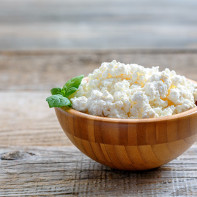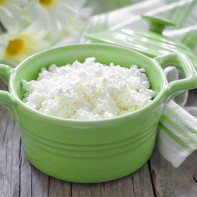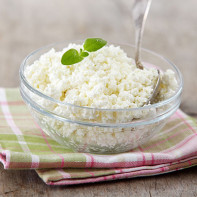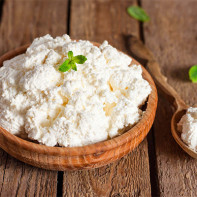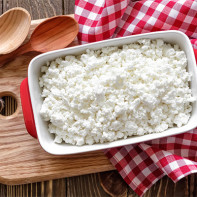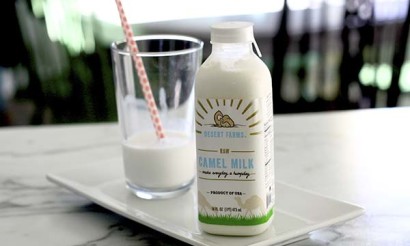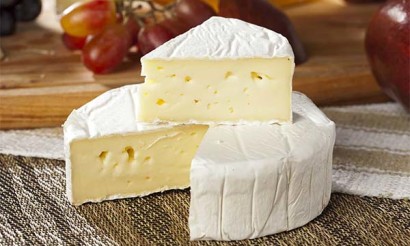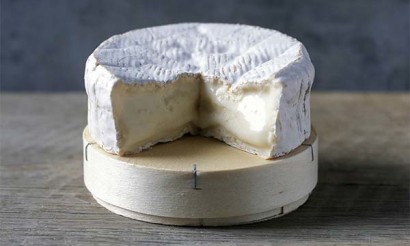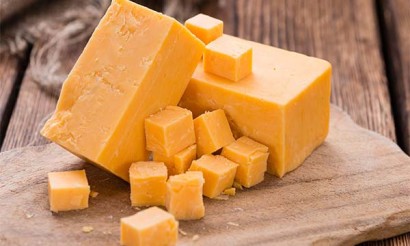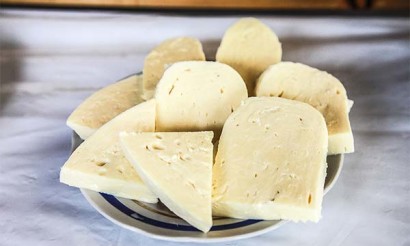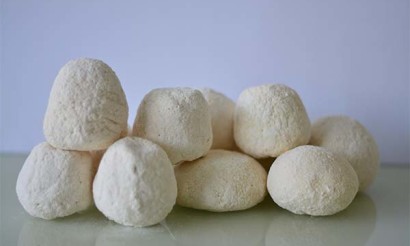Cottage cheese: composition, useful properties and recipes for cooking
Cheese is one of the most popular dairy products using animal ingredients. It is recommended for consumption regardless of age and gender of the person. It is very useful for every body. Cottage cheese has a unique composition and many varieties, which allows you to introduce it to the menu in various diets. The fermented dairy product can be purchased in a store or made at home yourself.
- Types of cottage cheese
- What is the difference between cottage cheese and cottage cheese mass
- Composition and calories
- How to use cottage cheese
- For Women
- For Men
- Pregnancy
- Breastfeeding
- For Children
- The benefits of goat curd
- Is powdered milk cottage cheese useful
- Skimmed cottage cheese: benefits and harms
- Are there any benefits from cottage cheese
- Is it possible to eat cottage cheese to lose weight
- Cottage cheese in medicine
- Diabetes mellitus
- For pancreatitis
- For Gastritis
- For the bowel
- For constipation
- For gout
- For colitis
- For the liver
- For hemorrhoids
- For cholecystitis
- Recipes of traditional medicine based on cottage cheese
- Cottage cheese in cosmetology
- For Face
- For Hair
- Harm and Contraindications
- How to choose and store cottage cheese
- Can I freeze it?
- How to test the curd for naturalness
- How to Make Cheese Cheese at Home
- With Milk
- From kefir
- How to Make Goat Cheese
- Why cottage cheese is bitter
- Why the cottage cheese is rubbery
- Why the curd turns out liquid
- What can be made from cottage cheese: Recipes
- Cheese cakes
- Cheese curd casserole
- How to Eat Cheese Cheese
- How much can I eat per day
- Can I Eat Cheese Cheese Cheese Every Day
- Can I Eat Cheese Cheese Cheese with Sour Cream
- Can I Eat Overdue Cheese Cheese
- Can I Eat Cheese Cheese Cheese After Training?
- Can I Eat at Night and on an empty stomach?
- Can I Eat Cheese Cheese during Lent?
- Can I Give Cheese to Animals
- Interesting Facts about Cheese Cheese
Types of Cheese
According to consumer qualities:
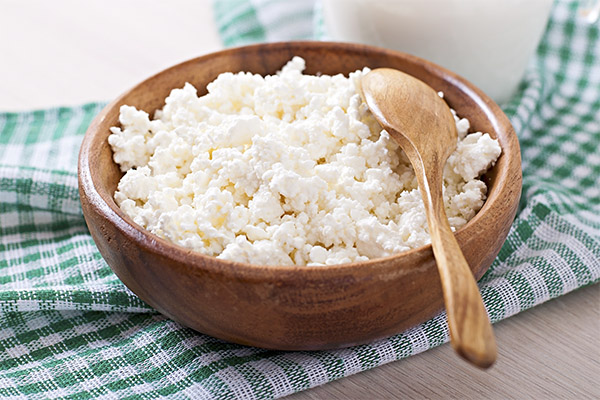
- Classic cottage cheese with a fat content of 4-18%.
- Lean - 1.8% fat content.
- Fatty - a product often home-made, has a fat content of 19-23%.
- Skimmed cottage cheese, it has less than 0.1% fat content.
- The product with various additives in the form of raisins, nuts, dried fruits, etc.
Also cottage cheese can be divided by consistency into two types. The first type includes cereal - this is characteristic of homemade products. And the second type - pasty, such curd has an oily structure and is represented by a homogeneous mixture.
What is the difference between cottage cheese and curds
Both products are fermented dairy products that can be consumed raw or used to prepare various dishes. Their base is cottage cheese. It is a pure fermented dairy product obtained by the interaction of milk and sourdough. For the curd mass is characterized by the addition of cream, condensed milk, butter, and various dried fruits.
The consistency of cottage cheese has a grainy structure, cottage cheese mass is characterized by a pasty form, which allows it to be used for spreading on bread. Cottage cheese is not always consumed in its pure form, it is usually used for baking, as for curd mass, it is a ready product that can be served as a dessert.
The caloric value of curd mass is higher. This is because it contains cream, condensed milk, and sour cream. If it also contains dried fruit, vanilla sugar - this makes the mass even more caloric.
Composition and calories
The composition of cottage cheese detected a large number of vitamins and minerals. Among them - vitamin A, PP, C, E, B vitamins. Of minerals, cottage cheese is rich in sodium, calcium, potassium, phosphorus, iron, zinc, selenium, magnesium. In addition, cottage cheese is characterized by a number of substitutable and essential amino acids.
The caloric value of sour-milk product depends on the percentage of fat content. Skimmed products have a caloric value of 70 kcal per 100 grams, lean and fatty varieties are characterized by the caloric value of 86 and 156 kcal per 100 grams, respectively. The caloric value of fat cottage cheese is 225-250 kcal per 100 grams.
How is cottage cheese useful?
A dairy product such as cottage cheese is made by heating fermented milk. It is a natural product and is of great benefit to the human body. The main value of the product is that it contains proteins that are easily digested. It can also replace meat for vegetarians.
By improving fat metabolism cottage cheese is used in diets in the treatment of hypertension, liver. Useful product for weight loss, is involved in the formation of blood hemoglobin.
For women
Cottage cheese is very useful for the female body. Due to the content of tryptophan and methionine, it normalizes the emotional state, improves the mood, which is very important during hormonal changes in the female body. This applies to PMS, menstruation, menopause. Lean cottage cheese contains a lot of calcium, vitamin PP and phosphorus. These components can strengthen teeth and bones, improve the condition of blood vessels, restore intestinal microflora.
For men
Men of all ages are recommended to eat cottage cheese. The product is good for the male body with its high calcium and protein content. Protein helps accelerate the growth of muscle mass. Minerals in the sour-milk product contribute to the normalization of the central nervous system and the cardiovascular system. Cottage cheese prevents the development of atherosclerosis, protects against stress, depression, improves memory and mental abilities. Due to the calcium content strengthens bones and teeth. It is recommended to use it in case of fractures.
Sports men are often accompanied by sprains and tears of ligaments. Natural cottage cheese, made at home, contributes to a quick recovery.
When pregnant
The diet of a pregnant woman must include dairy and fermented dairy products. The protein casein contained in cottage cheese can be a substitute for animal protein. It has a high nutritional value and is easily absorbed by the body. Calcium in cottage cheese participates in the proper formation and development of fetal bone tissue. If the baby does not get enough of this vitamin with food, it will take the missing amount from the mother's body. This leads to deterioration of hair, teeth, and nails of the woman. Using enough cottage cheese protects against such problems.
Phosphorus, which is present in the fermented milk product, takes part in the formation of muscle tissue. B vitamins have a beneficial effect on the nervous system of a pregnant woman, folic acid protects the fetus from malformations. Bifidobacteria in the product ensure the normal functioning of the gastrointestinal tract, which helps to reduce toxemia. The content of iron increases the level of hemoglobin.
When breastfeeding
Animal protein in cottage cheese is easily absorbed and improves metabolic processes in the body of a nursing woman. This allows you to recover from childbirth in a short time. Also cottage cheese increases the amount of breast milk. When breastfeeding, the use of this fermented dairy product helps to compensate for the lack of calcium in the body of a young mother.
For normal functioning of all systems and organs it is enough for a nursing woman to consume 100-200 grams of cottage cheese a day.
For children
Due to its useful properties, cottage cheese should be an obligatory product in the diet of children. Calcium, which is contained in this lactic acid product, is the basis of the bone system of a growing child. Deficiency of this substance leads to osteoporosis and spinal diseases. Protein and fat in cottage cheese are necessary for normal growth and development of the child's body.
Antibacterial components in the product restore intestinal microflora, and due to the low acidity does not irritate the mucous membrane of the stomach. It is worth noting that cottage cheese is much easier for a child to digest than kefir. Vitamin B2 has a beneficial effect on the child's vision and skin condition.
The product is contraindicated for children with an individual intolerance, with kidney disease and in case of an allergic reaction to the components of cottage cheese.
For children under three years of age a special natural sour milk product is used, in the manufacture of which no dyes, preservatives or flavor additives are used. As a complementary food, cottage cheese can be introduced from the age of six months, starting with one teaspoon. One year old child can already increase the rate to 40 grams. To calcium is better absorbed by the child's body, it is recommended to buy cottage cheese, which are enriched with vitamin D.
The benefits of goat curd
Goat's milk-based cottage cheese is considered healthier. This is because goat's milk is better digested than cow's milk. It is for this reason that after breastfeeding babies can be transferred to goat's milk.

In terms of amino acids and protein, goat's curd is close to meat, but has less calories. The main useful component of goat's sour milk product is calcium, which promotes normal growth and strengthens the bone system. In addition, it contains minerals such as magnesium, phosphorus, B vitamins. Goat product is especially useful in the treatment of osteoporosis. When choosing such cottage cheese, you need to pay attention to the color of the product - it should have a white color.
Consuming goat's cottage cheese, you should know the measure, because it contributes to an increase in blood cholesterol levels. If a person has diseases of the cardiovascular system, it is necessary to choose less fatty products.
Is powdered milk curd useful?
To understand whether powdered milk curd is useful, it is necessary to know what it is. In fact, powdered product is a powder that is formed by drying pasteurized milk. This occurs at a temperature of 150-180 degrees. After that, the mass cools and then is sifted. The peculiarity of such milk is that after mixing it with water, it becomes as if reconstituted. Such a product has a longer shelf life. It also contains all the useful minerals, fats and proteins. This product is easily digestible.
Dried milk curd acquires a low fat content. Thus, made from dried milk curd also has many useful substances, as well as a product made from whole milk.
Skimmed cottage cheese: benefits and harms
Skimmed cottage cheese is considered to have a fat content of no more than 0.1 percent. Despite the lack of fat content, this product has a caloric value of 71 kcal per 100 grams. Usually this fat-free cottage cheese is used in the diet for strict diets to provide the body with useful vitamins and minerals.
However, skimmed cottage cheese is not as useful as it may seem. Thermal processing loses most of the vitamins and useful trace elements.
It should also be noted that it is impossible to completely defatten such a product, so it is not recommended to use it when actively losing weight. In addition, such a sour milk product is not recommended for use by pregnant women, it can harm the baby.
Are there benefits to cottage cheese
The usefulness of the curd mass depends on the quality of the cottage cheese that was used for its preparation. In the manufacture of this product is not subjected to heat treatment, which allows you to save all the useful properties. In addition to protein, which is quickly absorbed by the body, curd mass contains a large number of minerals such as calcium, iron, magnesium, potassium, selenium and others.
Cheese curd has the same benefits as pure cottage cheese. If the product is of high quality, it enriches the human body with B vitamins, which improves mood. Also, this product contains proteins and fats that improve bowel function.
The daily norm of cottage cheese is 200 g. If you constantly exceed this figure, kidney disease can occur, cholesterol levels will rise. When buying, you should pay attention to the product packaging, it should not be damaged, have a sticky and wet surface. If the curd mass is stored on the counter for more than three days, it is better to refuse such a purchase.
Can I eat cottage cheese while losing weight?
It is generally believed that when losing weight, you can use only fat-free sour milk product. When including cottage cheese in the diet, it is important to adhere to certain rules. It is recommended to eat this product in the first half of the day, because it takes about three hours to digest it, while kefir or ryazhenka are digested within an hour.
For dinner you can eat no more than 2-3 tablespoons of cottage cheese. They can be added to a light vegetable salad. This will protect the body from falling asleep for a long time and discomfort.
Cottage cheese in medicine
In addition to the fact that cottage cheese is a very tasty food, it also has a number of useful properties. This lactic acid product has in its composition many vitamins, trace elements, protein, which are undoubtedly necessary for the normal growth and development of each body. Therefore, it is recommended to include it in the diet for various diseases.
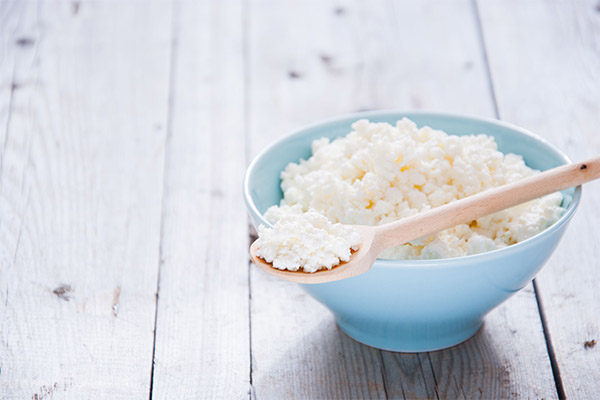
In case of diabetes
If a patient with diabetes consumes nonfat cottage cheese, it helps to reduce his weight, normalize metabolism, reduce sugar levels. Due to the high content of vitamins and minerals, the product helps to improve the patient's immunity.
In the patient's diet, cottage cheese can be present only in pure form, it is not recommended to use curd mass. Eat this product for diabetic patients should be several times a day, the portions should be small.
Important: The glycemic index of fat-free cottage cheese is 30 units.
When pancreatitis.
Cottage cheese is indispensable for the recovery of the pancreas. Animal proteins and other useful substances in the composition of this product help to restore the cells of the stomach and pancreas. In acute pancreatitis, small portions of cottage cheese are allowed to include in the patient's menu already on the fifth day of treatment, but it is necessary to consult a doctor. It is recommended to use only fresh cottage cheese. You can eat no more than 300 g of the product several times a week.
If you have gastritis
In the acute form of gastritis, the use of cottage cheese is contraindicated. In the remission stage, low-fat cottage cheese is allowed, but it should not be raw. It is possible to prepare cheesecakes or cheesecake. If the doctor allows you to eat cottage cheese, it should still be ground in a blender to obtain a paste-like mass. This is done to ensure that even the smallest particles of the product do not traumatize the mucous membrane of the patient's stomach.
Gastritis with high acidity involves the intake of cottage cheese, which has been heat-treated, i.e. in the form of cheesecakes, dumplings, etc.
With reduced acidity, the consumption of small amounts of fresh cottage cheese is allowed.
For the intestines
Sour milk bacteria in the composition of cottage cheese contribute to the restoration of intestinal microflora. Therefore, for normal operation of the digestive system, this product should be included in your diet. At the same time this product is allowed to eat fresh, you can also add a variety of components. Cottage cheese does not cause bloating and does not irritate the intestinal mucosa.
Properly drawn up a diet that includes cottage cheese has a positive effect on the formation of feces, due to which there are no difficulties with bowel emptying.
For constipation
To normalize the stool and soften the accumulated stool masses, it is recommended to add a fatty dairy product to the food. For the right effect, it is recommended to buy products with a fat content of 2-9%.
Only fat-free cottage cheese can lead to constipation. This is due to the fact that the product has a dry consistency and is poorly digested, resulting in hard and dense feces.
In gout
In this disease, it is acceptable to use cottage cheese, but it is recommended to give preference to nonfat products. It is better to consume it in the morning as a main meal. Patients with gout are allowed to eat no more than 400 grams of cottage cheese a day. The dairy product has a favorable effect on metabolic processes, helping to eliminate uric acid and other substances that are harmful to the joints.
In colitis
In the case of exacerbation of chronic colitis in the diet of the patient is allowed strained cottage cheese. In the remission stage of colitis, it is also recommended to consume a sufficient amount of this delicacy. Colitis with constipation requires the inclusion of fatty cottage cheese in the diet, with the manifestation of colitis with diarrhea, a fresh product with less fat content is allowed.
For the liver
Cottage cheese contains amino acids that participate in fat metabolism, which facilitates liver function. In addition, the ingredients in the product have antioxidant properties, which allows you to protect liver cells from destruction. It is not recommended to abuse fatty varieties of cottage cheese. The product must be fresh and have a fat content of no more than 5%.
Hemorrhoids
To alleviate the symptoms of hemorrhoids, it is important to follow a diet. Cottage cheese is one of the approved foods for this disease. It is beneficial due to the micronutrients in its composition. The cottage cheese helps to normalize the intestinal microflora. It will help to soften the stool masses. However, during the exacerbation of the disease, the sour-milk product can be eaten after three days.
In cholecystitis
Patients with cholecystitis can include low-fat cottage cheese in their diet. After an exacerbation, the patient is allowed to eat low-fat cottage cheese. This dairy product is rich in lipotropics, which is very important in cholecystitis. During the exacerbation of the chronic disease, the patient is prescribed fasting.
Recipes of traditional medicine based on cottage cheese
Cottage cheese has a large number of vitamins and micronutrients, useful for the body. However, this product is able to bring benefits not only when used internally, it can also be used externally. There are many recipes based on cottage cheese. For example, folk healers use it in the treatment of bronchitis and the prevention of pneumonia. Use such a recipe can only be used if antibiotics are not used for treatment. To do this, you need to take cottage cheese of any fat content and mix it with a small amount of honey. So, for 100 grams of cottage cheese product will need a tablespoon of honey. The cottage cheese should be warm. The resulting mass should be applied in a small layer on the chest, cover with wax paper, a towel and a warm scarf. Such a compress should be kept overnight. Before going to bed, you should drink herbal cough tea. In the morning, the compress is removed.
Using cottage cheese to treat boils. To do this, you need to heat cottage cheese to a temperature of 40 degrees and cover the sore area several times. This procedure prevents inflammation, and the boil passes in a short time.
Cottage cheese in cosmetology
Cottage cheese is a product of the processing of milk, which has many beneficial properties for the body. To maintain the natural beauty of the hair, face, you can prepare various masks based on this product. Cottage cheese gently cleanses the skin, evens out its tone and has a moisturizing effect.
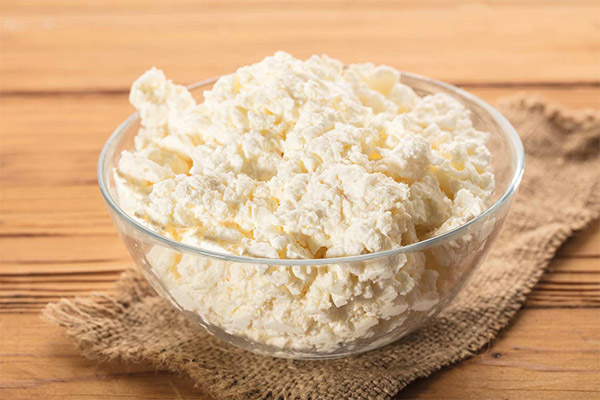
For Face
To purify the skin of the face and enrich it with nutrients, you can use raw cottage cheese mask. To do this, take a couple of spoonfuls of fresh milk product and rub it into the skin. This will cleanse it of keratinized cells. Such a mask also helps to get rid of acne.
As you know, lemon has a whitening effect. You can take 4 tablespoons of fresh cottage cheese and one tablespoon each of honey and lemon juice. All the components should be mixed and applied to the face. The mask should dry. After that, it should be washed off with water. After the first application, the skin becomes smooth. With repeated applications, the tone of the face improves.
For hair
Cottage cheese can be used to make at home masks for hair. For example, to give hair shine and volume, it is enough to take cottage cheese and fruit puree in equal quantities, mix them and apply to the hair. The mask should be kept for half an hour. After that, the hair should be washed with shampoo. As a fruit for dry and normal hair you can use peach, banana, apricot. For oily hair is suitable apple, kiwi.
To prepare a mask for dandruff you will need 100 grams of fat cottage cheese and a small amount of ground black pepper. For a better effect, you can add a little tar soap to the resulting mixture. The mask is applied to the hair for 20 minutes, then rinse with warm water and shampoo. Such a procedure should be performed twice a week.
Harm and contraindications
Despite its many useful characteristics, cottage cheese is capable of harming the human body. First of all, it is necessary to consider the freshness of the product. It should be remembered that the lactic acid product is perishable, in it the E. coli begins to multiply the fastest. When buying it is important to check the date of manufacture. Such a product is stored for no more than three days. Otherwise you can get food poisoning.
The cottage cheese product is contraindicated in cases of individual intolerance. Also you should not use cottage cheese for those who have problems with the kidneys. This is due to the fact that the high protein content in this product is a significant load on the organs of the excretory system.
Do not be fond of cottage cheese and in diseases such as atherosclerosis, obesity.
How to choose and store cottage cheese
- When choosing, you should pay attention to products in transparent packaging - so you can see what's inside. The packaging should not be damaged. You should also pay attention to the date of manufacture.
- If the lid or packaging is bloated, it is better to discard the purchase. The yellow color of the product indicates that it is spoiled. Good-quality cottage cheese should not be runny.
- The color should be homogeneous, and if this is not observed it means that products of different quality were mixed during production, or fresh curd with spoiled curd.
- The quality product should not contain ingredients with unfamiliar names.
If cottage cheese is purchased in a plastic bag, you should not store it in it, so the product will quickly go bad. It is better to store it in an enamel bowl with a lid, and the use of containers is also possible. In the refrigerator should choose the coolest place, the optimal temperature is +2-+6 degrees.
Sour milk product retains its useful qualities for three days, after this time, it is recommended to subject cottage cheese to heat treatment, bake with his help casserole.
Can I freeze
Cottage cheese can be frozen. It can be kept in the freezer for several months. After defrosting, the dairy product retains its taste characteristics, but in terms of consistency it can become like a curd mass. Frozen cottage cheese should be no later than four days after production. It is recommended to freeze in small portions, as it will be impossible to freeze again.
It is also possible to freeze foods that have been prepared with this component, such as cheesecakes.
How to test cottage cheese for naturalness
Good cottage cheese has a grainy structure, has a milky-white color. This indicates that natural milk was used to make it. If you rub the curd product between your fingers, a good product will change its consistency and leave greasy marks on your fingers.
High quality cottage cheese should be a little crumbly, if it has a homogeneous consistency - palm oil was used in its manufacture. The natural product should smell like milk.
The taste of natural cottage cheese is neither sour nor sweet, the product has only a slightly sour taste. The taste depends on the percentage of fat content, that is, the lower the fat content, the less pronounced the taste of cottage cheese will be.
To keep the dairy product longer, some manufacturers add palm oil and other components. To check the naturalness of the selected product, you can use several ways. You can take a piece of cottage cheese in your mouth and hold it on your tongue for a few seconds, if the product is natural, you will not feel a greasy film.
You can also put a teaspoon of cottage cheese in a glass of water and stir it. If a yellow film appears - it means that there are vegetable oils in the product.
How to Make Cottage Cheese at Home
To treat yourself with the benefits for the body, you can prepare cottage cheese with your own hands at home. There are many simple recipes from different ingredients.
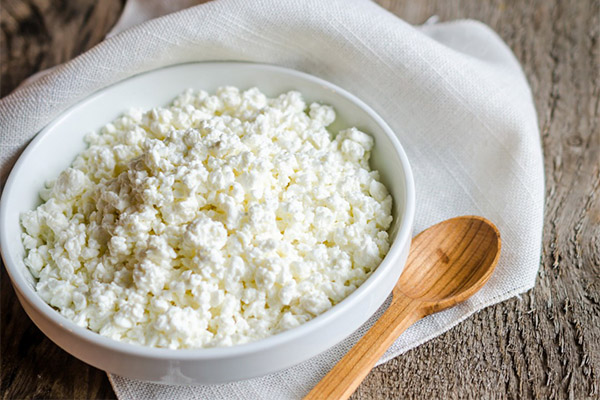
From milk
First, you need to pour a few liters of milk into a pot, cover it and leave it in a warm place for 24 hours. This way it will sour. You can add a little sour cream, then the cottage cheese will acquire a slightly sour taste. When the milk begins to sour, put the pot with it on a water bath over a low heat. When the mixture boils and a yellowish liquid begins to form, you must turn off the fire and let the mass cool.
Next, you need to take a sieve, cover its bottom with two layers of gauze. The cooled mixture should be gradually poured into the sieve, and then the edges of the gauze should be lifted and tied so that it can be suspended. After half an hour, all the whey will drain off, and what remains inside the gauze is the homemade curd.
With kefir
To make cottage cheese, you can use not only milk. Kefir is also suitable for this purpose. And instead of the usual heating method is used freezing. It is enough to put a package of kefir in the freezer in the evening. By morning the product will be completely frozen.
After that you should carefully open the package and put the frozen piece on a sieve for defrosting. The bottom of the sieve should be covered with gauze in two layers. After 9-10 hours the whey should drain, and on the gauze will remain a delicate curd, which will have a pasty structure.
How to make goat's curd
To prepare a fermented dairy product from goat's milk, it is enough to prepare a liter of fresh milk and two pinches of salt. First you need to pour the milk into a saucepan, salt and bring the mass to a boil. After this, the pot should be removed from the stove, covered with a lid and left for a day at room temperature. Next, the fermented milk should be placed in an enamel bowl and heated over low heat. It is not required to boil, only to warm, otherwise the product will acquire an unpleasant taste. Then place a colander in a deep bowl and cover its bottom with several layers of gauze. Pour the warmed milk on the gauze and wait until all the whey flows out. You only need to lift the edges of the gauze, hang it on something and wait until all the remaining liquid has drained out.
Why the curd is bitter
If the curd is fresh, but still bitter, there may be several reasons for this. First of all, it may be due to the pregnancy of the cow whose milk was used to make the product. Bitterness can also occur due to bitter grass in the animal's feed.
Cottage cheese can be bitter if stored improperly, when the product is past its expiration date. If the cottage cheese has been improperly prepared or pepsin doses are exceeded, a bitter taste may also appear.
Cottage cheese with a bitter aftertaste can be eaten, but it is still not recommended to introduce it to the diet of children. Use such a product as soon as possible, not storing it for a long time.
Why the curd gets rubbery
Due to overheating of sour milk, cottage cheese can turn out rubbery. As you know, it is formed as a result of the curdling of milk protein. When sour milk is heated, curdling occurs very quickly, so there is stiffness. One must remember that the less sour milk is heated, the more tender the finished product will be.
Rubber cottage cheese can turn out because of poor-quality milk. Perhaps the animal has mastitis or a new food was introduced into the diet.
The cause can also be the starter used. It is recommended to use sour cream and whey, which is obtained by self-fermentation.
Why the curd is runny
The curd becomes liquid when the mass is not finished, although it is very easy to overcook it (then the product will turn out hard). The mixture used to make the curd should be hot, no more.
It is also important to hang the gauze with the curd so that all the whey will drain out.
What can be made from cottage cheese: recipes
Today there are many different recipes based on cottage cheese all over the world. Recipes for dishes can differ in local features, methods of making.
Cheesecakes
Cheesecakes are a dish that probably everyone has tried. They are very healthy, nutritious, it is not difficult to prepare them. You will need 0.5 kg of cottage cheese with medium fat content, three tablespoons each of sugar and flour, a couple of fresh eggs, vegetable oil, some raisins. First you need to wash and steamed raisins. Then mix the cottage cheese with sugar and add eggs and flour to the mixture. Then you should knead the dough, add raisins and mix again.
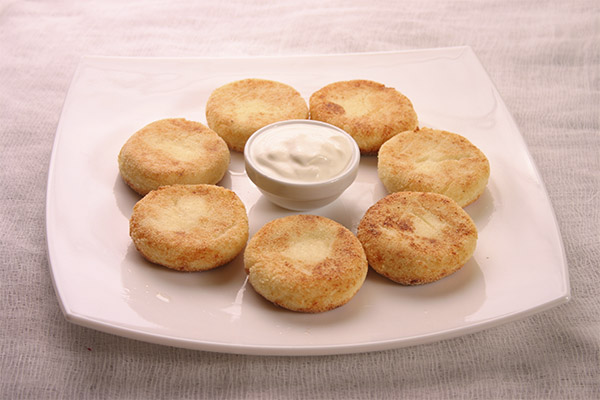
It is necessary to place the prepared cakes on a board, having dipped them in flour, and leave them for 5-10 minutes. After that, pour a sufficient amount of sunflower oil into a frying pan and fry the cakes on both sides over low heat. Ready cheesecakes can be served hot, adding sour cream to them.
Cheese Casserole
You can cook cottage cheese casserole, which is also characterized by usefulness, ease of preparation. So, you need 300 g of cottage cheese, 4 tbsp of semolina and sugar, 0.5 cup of sour cream with a fat content of 15%, a couple of eggs, raisins, a bag of baking powder, a pinch of salt, vanillin and a little vegetable oil.
To begin with, you need to wash and steep the raisins. Then you need to mix the semolina with sour cream and allow the mass to stand for 20 minutes. After that, in a bowl mix the cottage cheese and semolina with sour cream, add vanilla, baking powder, salt and mix everything thoroughly. You can use a blender. The result should be a pasty mixture without lumps. Next, add the pre-whipped eggs with sugar and mix everything. Then add raisins. The dough is ready. The only thing left is to grease the mold, sprinkle it with semolina, pour the dough into the mold and send it to the oven for 40-45 minutes. The finished casserole is served warm with sour cream.
How to eat cottage cheese
It is recommended to eat cottage cheese in the first half of the day, for example, for breakfast. So the product will provide the body with energy, necessary vitamins and minerals for the whole day. You can add cottage cheese to the lunch menu, but for this you will need to choose dishes that will be combined with this product. As you know, it is recommended to eat soups at lunch, often with the addition of meat, which suggests that it is better to give up cottage cheese at lunch.
How much you can eat per day
You can consume cottage cheese from 100 to 300 g per day. For women the norm is 200 grams of the product, men are allowed to eat 300 grams per day. Overeating is not recommended, otherwise it will adversely affect the state of health.
Is it possible to eat cottage cheese every day?
If you eat cottage cheese in unlimited quantities, it can harm your health. After all, this fermented milk product contains substances, the excess of which leads to disorders of the digestive system, the emergence of heart disease, the development of obesity and atherosclerosis. Therefore, taking into account the norms for men and women it is not recommended to eat cottage cheese more than 2-3 times a week.
Can I eat cottage cheese with sour cream?
If you add sour cream to cottage cheese, you get a very healthy dish for the gastrointestinal tract. Such a dessert does not irritate the mucous membrane of the stomach. When adding sour cream accelerates the growth of muscle mass. It is only important to choose the correct fat content of both components. Such a dish supplies the body with energy, increases endurance. You can add ingredients such as raisins, prunes, honey, nuts, etc. to this dessert.
If you add parsley and dill and garlic to cottage cheese with sour cream, you will improve the quality of your sex life. This is because greens and garlic contain a lot of zinc, which is involved in the production of such a hormone as testosterone. With a lack of zinc in the body develops erectile dysfunction, reduced muscle mass.
Is it possible to eat expired cottage cheese?
Cottage cheese refers to perishable products. If it is not stored properly, it begins to multiply pathogenic bacteria that once in the body can lead to botulism. The risk of poisoning is very high. If more than 3-4 days have passed since the product was made, it is better to refuse to eat it, at most, use it for baking.
Is it possible to eat cottage cheese after a workout?
Cottage cheese after a workout is not only possible, but also necessary to eat. It is a harmless product that replenishes the energy expended during the workout and provides muscles with protein nutrition. It is recommended to eat it fresh. Cheese curds should not be used because they contain a lot of sugar and harmful additives that will harm not only your muscles but also your health in general. Thermal processing loses some of the useful properties of cottage cheese, so for the best effect it should be present in the diet after a workout in its fresh form.
Can I eat at night and on an empty stomach?
All products, regardless of the degree of calories, should not be eaten before bedtime. The last meal should be at least three hours before bedtime. But if you still want to eat a lot, you can choose non-fat cottage cheese, which is not as caloric. It will cause the least harm to the body and will be quickly digested. It is recommended to eat cottage cheese before 5 p.m., not later.
As for the consumption on an empty stomach, it is better to give up this habit. This is due to the fact that in this case, the product is able to do more harm than good to the body.
Is it possible to eat cottage cheese during the Lent?
The main requirement of all fasts is to abstain from food of animal origin. These include eggs, milk, meat, fish and all dishes using these products. Since the main ingredient of cottage cheese is milk, it cannot be eaten during Lent.
However, there are some exceptions. Restricting cottage cheese during Lent does not apply to those who need the product. First of all, this applies to pregnant and lactating women. Available in cottage cheese calcium and many other useful elements are very important for the normal development of the fetus, as well as for the growth of the skeleton of the child in the first year of life. Also cottage cheese can be taken by patients who have problems with bone strength. They require a constant supply of calcium in the body.
Should pets be given cottage cheese?
Animals need cottage cheese just as much as people do. Pets need calcium to strengthen their bones, and protein is important for activity. The amino acids in cottage cheese help normalize the gastrointestinal and nervous systems of pets. Especially cottage cheese is important for young puppies, kittens, which need a strong immune system, strong musculoskeletal system.
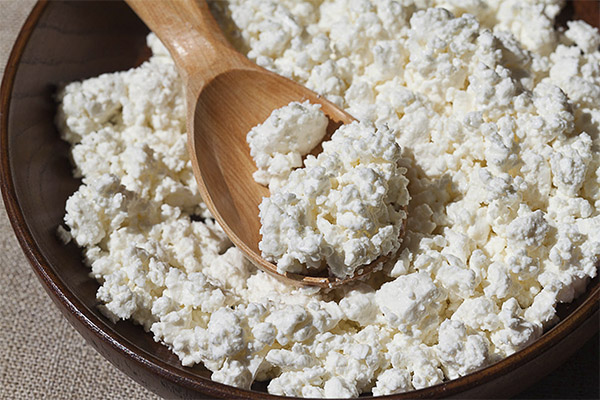
However, it is not recommended to give animals fat cottage cheese and in unlimited quantities, otherwise it will harm the body of the beloved pet.
Interesting facts about cottage cheese
- Earlier in India, at the feast of the god Krishna, it was obligatory to break a vessel with curd. People believed that such a procedure would bring good luck for the whole year.
- In Russia, industrial cottage cheese appeared only by the end of the 19th century. Before that, only cottage cheese was in people's diets.
- Calcium and vitamin D in cottage cheese reduce the risk of breast cancer. This became known during the research at Harvard, which took 16 years.
- In ancient times, people used to eat curd not only fresh, but also pressed it, making it ready for the winter. This allowed them to preserve all the useful components of the product. As a result of pressing, the sour milk product became as hard as plastic, so the idea of using it to create buttons appeared.
«Important: All information on this site is provided for informational purposes only for educational purposes only. Please consult with a health care professional before using any of our recommendations. specialist before using any of the recommendations. Neither the editors nor the authors shall be held liable for any possible harm caused by materials."

